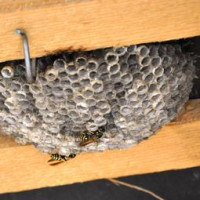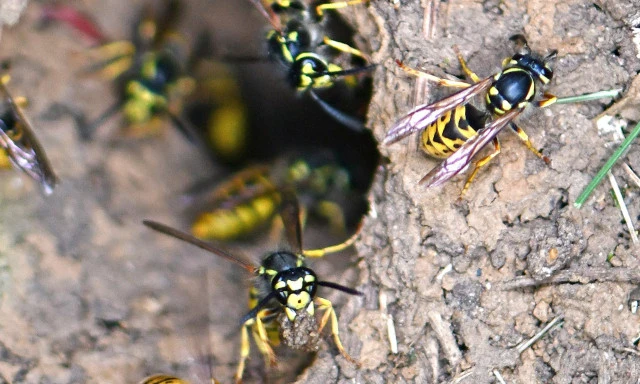How to Get Rid of Wasps in New Zealand
Wasps can quickly turn your backyard or outdoor area into a no-go zone. Knowing how to spot, treat, and prevent wasp nests is the key to keeping your home and family safe. This simple 1-2-3 step wasp control guide shows you how to identify different wasps, locate their nests, and eliminate them for good.
Are all wasps pests?
Not all wasps are troublemakers. New Zealand has several native wasp species that aren’t considered pests and are generally less aggressive toward people.
The real problem comes from the introduced species: Mainly German and Common wasps. New Zealand has some of the highest numbers of these wasps anywhere in the world. They flourish here because there are no natural predators to keep them in check, our winters are mild, and food is plentiful. Paper wasps are also introduced, but they’re less widespread and not as invasive.
Yellow-legged hornets are a recently introduced invasive species that looks similar to wasps and pose a significant risk to New Zealand's bees. They need to be eradicated quickly. If you suspect you have a Yellow-Legged Hornets on your property please report it immediately online at report.mpi.govt.nz.
Yellow-legged hornets have distinctive dark legs with bright yellow tips. In contrast, Common wasp species in New Zealand, such as the German wasp (Vespula germanica), typically have uniformly yellow or yellow-striped legs. The yellow-legged hornet is also much larger than honey bees and Common wasp species seen in New Zealand. Find out more about this invasive species on the Ministry of Primary Industries website.
- Common and German wasps

Common wasp nest (note the outer covering)
German and Common wasps form large colonies, often building football-sized nests when hanging out in the open, though they’ll happily adjust to fit tight spaces such as wall cavities, hollow trees, or underground holes. These nests are enclosed in a papery shell and start out the size of a golf ball.
In New Zealand, they most often nest in holes in the ground surrounded by grass or other plants. Wasps will clear a small flight path through the vegetation, landing on the ground at the entrance of their nest, then walking inside.

Wasp nest hole in the ground
If they set up in your soffits or in a tree they’ll fly towards the nest, land and then walk inside. Treating plants and walls around a nest won’t work as they’ll fly past it, for best results you need to treat the nest itself and if using NO Wasp Eliminator the area the land on and walk through before entering the nest (you can identify this area in Step 1 below).
German wasps and Common wasps also nest under soffits/eaves of homes, in sheds, or hanging from trees. They like warm, sheltered areas but not direct sunlight on their nests.
- Paper Wasps
Paper wasp nest (note it's open with no covering around it).
Paper wasps build open, umbrella-shaped nests made from chewed wood (fences, decks, tree bark, and so on). These nests are smaller and easier to spot, often hanging from soffits, sheds, or branches.
Easy 1-2-3 step wasp control programme
It's important to understand what type of wasp you're dealing with before you attempt to get rid of it. It can mean the difference between success or a swarm of very angry wasps.
- Step 1 - Search
The best way to control wasps is to treat the nests so that you kill the whole colony. You can improve your chances of finding the nest by baiting and watching them.
Watch the wasps - Wasps are not aggressive unless provoked, so from a few metres away you can safely observe their movements. Wasps feeding on flowers, wood, sugary drinks, or pet food will usually fly in a straight line back to their nest once they’ve eaten. If that doesn’t work set out cat food or tinned fish for them. They will scoop up a lump and carry it back to their nest. You may be able to follow the wasps carrying their load of bait.
Follow - After 5–10 minutes you’ll get a feel for which direction the nest lies. Look for wasps funneling into one spot or flying back out in search of food.
- Step 2 - Destroy
Hard to access nests/nests in holes (German & Common Wasps)
Give the NO Wasps Eliminator pack a light shake then open the lid. Apply 5-6 sharp puffs directly at the nest entrance and where the wasps land. Check again several hours later. If there is still activity, or the powder has become damp, repeat the application. For wasp nests below concrete, paths, tree stumps etc. apply the powder along all the edges where they appear to be entering the nest. The powder contains insecticide and acts as a carrier, sticking to the wasps as they walk through it. They then carry it into the nest, spreading it through the colony. Because it’s a powder, it helps keep the wasps calm during treatment.
NO Wasps Nest Killer Aerosol will successfully kill Common and German Wasps. Its aerosol nature however can upset them, which can be a problem given their bigger colony size and the fact there will be more aggressive wasps willing to attack. It can also be tricky getting the aerosol into hard to reach areas, something NO Wasps Eliminator combats by getting the wasps to walk the product into their nests.
Hanging and Exposed Nests (Paper Wasp Nests)
Give the nest a quick and thorough spray of NO Wasps Nest Killer Aerosol. This powerful spray reaches up to 4 metres and works instantly, making it ideal for exposed nests like those built by paper wasps. NOTE: NO Wasps Eliminator puff pack will effectively kill paper wasps and can be used, but a short sharp direct hit of an aerosol spray is more effective when dealing with an easier to access nest that has no covering. It also gets immediate results, while the Eliminator can take a few hours.
Tips
- Treat nests just before dusk or just after dawn, when wasps are less active.
- Do not apply treatments if rain is expected within two hours (or if it has recently rained and the area around the nest is wet).
- If possible, wear a beekeeper’s veil and gloves to avoid getting stung
- Step 3 - Protect
Once the nests are gone, keep wasps from coming back by spraying fences, decks, walls, and other landing spots with NO Wasps Total Protection Spray to control wasps that land on it for up to 3 months. This product also helps deter Asian paper wasps from chewing your timber fencing, furniture etc.
What to do if your are stung
If when watching the wasps they appear to agitated, wait for another day and time when they have calmed. It's not worth the risk of agitating them further.
Unlike honey bees, wasps can sting more than once because their stinger doesn’t stay behind in the skin. Their venom also releases a pheromone that alerts nearby wasps, making them more likely to attack, so if you’re stung, it’s best to stay calm and move away quickly. Applying a deodorant that contains aluminium can help soothe the pain of a sting.
For most people, a wasp sting is just a sharp, short-lived pain, but for those who are allergic, it can trigger a serious reaction known as anaphylaxis. Even if you're not allergic stings to the neck and face can result in your throat closing and danger to life. If you start feeling unwell, or like you're struggling to breathe immediately seek medical attention.
Rid your property of wasps and take back summer
Keeping wasps under control doesn’t have to be a battle. With the right know-how and Kiwicare’s trusted range of wasp control products, you can safely get rid of wasps, destroy nests, and stop new ones from forming. Whether you’re tackling German, Common or Paper wasps, following this simple 1-2-3 step plan will help you reclaim your outdoor spaces and enjoy a wasp-free summer around your home and garden.



